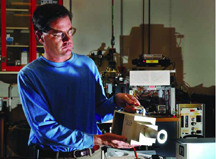
Last week’s foiled terrorist attack aimed at blowing up as many as 10 airplanes over the Atlantic was stopped short by British authorities.
The attackers apparently planned to bring down the planes by smuggling liquid chemical explosives disguised as drinks onto the aircraft. Reports said the intention was to mix liquids and assemble bombs in flight with various components.
Immediately after news of the foiled terror plot broke, Sandians John Parmeter and Kevin Linker, experts in the general area of explosives detection and members of Contraband Detection Technologies Dept. 6418, spent a hectic couple of days fielding questions from members of the national and local media. Among news outlets they talked to were the Los Angeles Times, Boston Globe, Baltimore Sun, The Associated Press, New Scientist, Albuquerque Tribune, KOB-TV Channel 4, and inquiries from CNN, Nightline, and Wired magazine, among others.
John says he doesn’t know what specific materials were to be used. He says there are materials that are not explosive individually, but when mixed with other materials become explosive.
“ANFO (ammonium nitrate/fuel oil) is a well known example,” he says. “This has been used in numerous car bombs in the UK.”
Ammonium nitrate by itself is not considered an explosive, but when mixed with fuel oil it becomes an effective explosive.
“The mixture is normally solid, but there are ways you could probably make it more like a liquid slurry,” he says. “There are some materials made of two components, where at least one component is a liquid, that would not be considered explosives separately but would make an explosive if mixed.”
He says “liquid explosive” is a catch-all term and can include a variety of chemicals such as nitroglycerin and related compounds, and ammonium nitrate slurries.
Some explosives can be used in both liquid and solid forms. Pure nitroglycerin is a liquid at room temperature, but Alfred Nobel’s invention of dynamite is a widely used solid explosive based on nitroglycerin, he says.
“With both liquids and solids there are things one could do to make the explosive more or less stable — i.e., more or less sensitive to detonation,” John says.
John works alongside other Sandians whose primary work is in trace explosives detection system development and test and evaluation of explosive detectors. Kevin and others in the department have been involved in the development of trace explosives detection portals for personnel screening, as well as handheld explosive detection systems.
Detection of liquid and solid explosives can in many cases be done using the same types of trace chemical sensors, he says. Furthermore, if an explosive is made by combining two components that are not explosives themselves, it does not follow that a trace sensor used for explosives detection could not detect the individual components. “If a sensor detects a mixture it will normally detect at least one of the components,” he says.
One generic difference between liquid and solid explosives is obvious — liquid explosives require some sort of container. “There might be some issues with corrosion, but there would be containers you could put liquid explosives in,” he says.
A variety of detectors are used at airports. Metal detectors that do not detect explosives might find bombs that have metal components. X-ray scanners are used to image the contents of carry-on luggage. Trace detection systems are used to swipe laptops and other personal electronic equipment, and personnel portals have been tested or used on a trial basis at some airports.
Ion mobility spectrometry (IMS) is a widely used trace analytical technique for detecting explosives. It is used to detect molecules or molecular fragments after they are ionized. The mobilities of these ions in an applied electric field are then measured. One of the requirements is that the molecules to be detected must form a stable ion of some sort. IMS can detect drugs, environmental pollutants, and other types of compounds in addition to explosives.